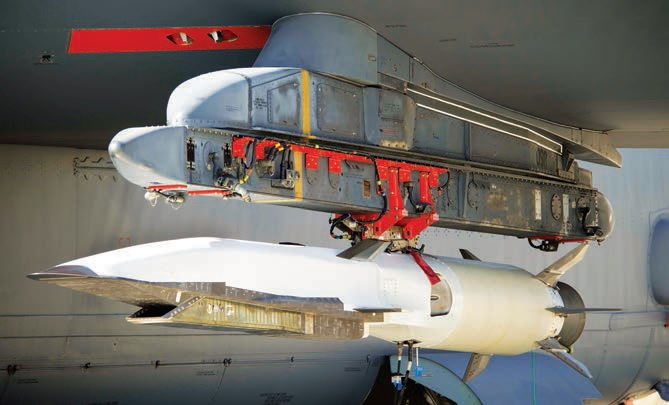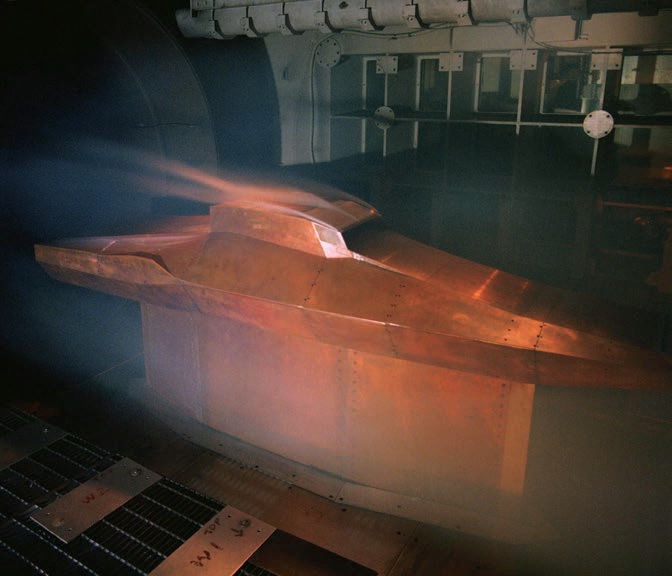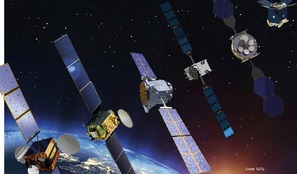On the morning of 1 May 2013, a 50-yearold B-52 bomber took off from Edwards Air Force Base in the high desert of California, bound west towards the Pacifi c Ocean. Tucked beneath the 25-metre-long left wing of the aircraft was a 7.6-metre unmanned craft designated X-51A Waverider, on the fourth and fi nal fl ight of a test programme conceived by researchers at the United States Air Force Research Laboratory to probe the limits of socalled ‘hypersonic’ fl ight, in excess of fi ve times the speed of sound.
The X-51A vehicles were built by The Boeing Company, each powered by a unique engine called a ‘scramjet’, which was in turn constructed by the Rocketdyne Corporation1, burning a relatively conventional jet fuel. Scramjets had long been seen as a key to sustained hypersonic fl ight in the atmosphere, and important steps in their development had already occurred in ground tests and in the air. However, prior to the X-51A, nearly 50 years of research and testing had yet to produce a practical, proven design.
As the bomber reached its designated drop point off the California coast, the X-51A was released from its wing pylon. A solid rocket motor derived from a US Army missile booster ignited and carried the test vehicle to Mach 4.8 (4.8 times the speed of sound), then separated and X-51A’s scramjet kicked in. For 210 seconds X-51A’s scramjet accelerated the craft to a final speed of Mach 5.1 before all fuel was exhausted and X-51A coasted to a programmed impact in the waters of the Pacific.
The X-51A Waverider prepares to launch its fourth and final flight. The cruiser achieved Mach 5.1 travelling 230 nautical miles in just over six minutes, making this test the longest air-breathing hypersonic flight ever
 The X-51A Waverider mounted under the wing of a B-52
The X-51A Waverider mounted under the wing of a B-52
Surface temperatures and associated heating rates, especially at leading edges, can destroy all but the most robust materials
The X-51A represented the state-of-the-art in aerospace research, in which high-fidelity numerical simulation was combined with ground test and flight experiment. As one in the long series of X-plane efforts, X-51A built on a number of precursor programmes that have made serious advances in high-speed flight, including the 1960s-era X-15, the Australian HyShot launches and NASA’s hydrogen-fuelled X-43. While each of these earlier efforts made important contributions to our understanding of highspeed flight, X-51A proved beyond any doubt that a high-Mach craft could be powered by a longlived engine that burns a petroleum-based jet fuel while surviving the intense heat and extreme aerodynamic forces associated with sustained hypersonic flight.
The limits of physics and knowledge
The term ‘hypersonic’ is somewhat arbitrary, but it is generally applied to flows starting at about five or six times the speed of sound, where a craft generates very strong shockwaves as it moves through the atmosphere, and where skin friction yields temperatures that are high enough to produce chemical changes in the surrounding air. However, there are no sudden delineating changes in flow properties that occur as a craft enters the hypersonic realm. This is in strong contrast to the transition that occurs as a vehicle passes through Mach 1, the speed of sound, where there is a change in the fundamental behaviour of the air moving past the craft.
Some of the challenges of hypersonic flight are connected to high temperatures and aerodynamic forces. Surface temperatures and associated heating rates, especially at leading edges, can destroy all but the most robust materials. The shockwaves produced on the vehicle, realised as sudden changes in pressure and temperature, can contribute significantly to drag and heating. There are also significant gaps in our basic knowledge of high-speed flow; for example, it is uncertain when the air moving past a hypersonic vehicle will change from a smooth laminar state to turbulence, with an associated increase in drag and heating.
Simulating hypersonic flight conditions on the ground with acceptable fidelity requires test facilities that operate under extreme conditions, and that at best can represent only small portions of the full flight procedure. The accurate numerical simulation of hypersonic flows is similarly challenging due to the extreme time scales; the addition of non-equilibrium chemistry; and the need to resolve fine shock structures, pushing the limit of modern computational fluid dynamics.
Traditional aircraft engines do not work above moderate supersonic speeds, so hypersonic flight requires either rockets or advanced airbreathing cycles – or some combination of the two. Airbreathing engines offer advantages over rockets for flight within the atmosphere, since oxidiser can be collected rather than carried on board in a fuel tank. Without the mass of oxidiser and associated tanks, an airbreather can travel further on a tank of fuel, or carry more useful payload for a given overall weight.
Airbreathing propulsion is a special challenge at high Mach numbers. The likely hypersonic engine of choice, the scramjet, functions by keeping the air that passes through the enginemoving close to flight speed.2 Timescales thus become important: the engines that powered the X-51A craft had to swallow air through an inlet, inject and mix fuel into the air, burn that fuel-air combination, and exit the nozzle in about one thousandth of a second. As a result of shockwave physics, the engine on a hypersonic vehicle must actually be designed as part of the whole vehicle in one integrated package, creating one of the most difficult design and optimisation problems in all of aerospace engineering.3 Control of a hypersonic vehicle is also a concern, though NASA’s X-43 and X-51A both showed that such was possible with a modern flight control system.
Scramjets can’t operate at lower speeds, and so must be paired with other propulsion cycles, such as a rocket or a high-speed gas turbine, to carry a vehicle from ground to hypersonic flight. A hypersonic aircraft might take off on turbines, then transition to scramjet at high speeds. That transition process represents a particular challenge, as it appears especially difficult to stretch the upper speed limit of a turbine to overlap with the lower speed limit of a scramjet.
An entirely different approach is an air liquefaction system, in which cryogenic fuel is used to condense captured air with a heat exchanger, which is then combusted in a rocket engine. A UK-based company, Reaction Engines, has been pioneering this technology, which has the advantage of converting a relatively conventional rocket engine into an airbreathing system. In principle, an air liquefaction system could operate from the ground all the way to orbit.
Scramjets can’t operate at lower speeds, and so must be paired with other propulsion cycles
 Mach 7 wind tunnel test of the full-scale X-43A model in Langley’s 8-Foot High Temperature Tunnel
Mach 7 wind tunnel test of the full-scale X-43A model in Langley’s 8-Foot High Temperature Tunnel
Drag versus heat
Hypersonic flight is not a new concept. Manmade objects have been flying at hypersonic speeds since 24 February 1949, when a two-stage American ‘Bumper’ rocket, assembled from a captured German V-2 with a WAC Corporal sounding rocket as an upper stage, reached a speed of 2.3km per second. Bumper flew less than a decade after German researchers Eugen Sänger and Irene Bredt did theoretical studies of hypersonic vehicle concepts capable of oceanspanning flights.4
With the start of the space age, hypersonic flight became practical, but only as a means of returning spacecraft from orbit. The problem of surface heating during spacecraft re-entry was recognised as a key challenge in hypersonic vehicle design. Work at the US National Advisory Committee for Aeronautics Ames Laboratory, led primarily by H. Julian Allen and A. J. Eggers Jr, focused on the use of very blunt geometries for hypersonic entry, which became the standard for spacecraft design.
These blunt shapes have high drag and so decelerate quickly, which means they are not suitable for a vehicle designed to fly an extended distance through the atmosphere. In contrast to blunt hypersonic forms, sharpnosed slender shapes are most appropriate for objects that need to accelerate through, or cruise in, the atmosphere at high speeds. These sharp configurations, including the X-51A, produce efficient lift with relatively low drag. Sharp leading edges and pointed noses also get extremely hot at hypersonic speeds.
The slender-winged hypersonic form is epitomised by the 1960s-era X-15 rocket planes that flew 199 times between 1959 and 1968.
Like the X-51A craft, each of the three manned X-15s were taken to altitude and dropped from under the wing of a B-52 bomber. Unlike X-51A, the reusable X-15 craft accelerated under their own rocket power to speeds up to nearly seven times the speed of sound, and then coasted to a landing at Edwards Air Force Base. Towards the end of the X-15 programme, interest focused on supplementing the rockets with a pylon-mounted scramjet. The X-15 programme was ultimately ended before a working airbreathing engine was flown; but efforts to develop such engines, which had actually begun in the late 1950s, were continued as part of the National Aerospace Plane Program of the 1980s.
Hypersonic technology could lead to vehicles that fly to orbit in part with airbreathing engines instead of rockets
The X-43A hypersonic research aircraft and its modified Pegasus booster rocket accelerate after launch from NASA’s B-52B launch aircraft. Minutes later the X-43A separated from the Pegasus booster and accelerated to its intended speed of Mach 7
A research team at the University of Queensland flew what is generally believed to be the first airbreathing scramjet in July 2002, which was followed by two successful flights of NASA’s X-43 that proved that scramjet thrust could be greater than vehicle drag. Experience gained in Australia has been applied to the joint Australian-US Hypersonic International Flight Research Experimentation (HIFiRE), collaboration that has included a series of sounding-rocket flights designed to explore various aspects of hypersonic aerodynamics, propulsion and vehicle design.
The applications of hypersonic technology can be sorted into three general categories: weapons, aircraft and spacecraft. High-speed weapons could include hypersonic cruise missiles, able to fly several hundred kilometres in a matter of minutes on scramjet power; or unpowered boostglide craft that reach hypersonic speeds on a rocket booster, and then glide at high speed to a precise impact. Hypersonic aircraft might see service for global cruising, crossing the planet in just a few hours.
Somewhat less ambitious but more readily achievable, hypersonic airbreathing engines might enable shorter-range tactical aircraft. For example, a next-generation reconnaissance plane might fly at Mach 6, replacing the protection of stealth with the invulnerability of speed. Hypersonic technology could also lead to vehicles that fly to orbit in part with airbreathing engines instead of rockets, operating more like airplanes than the expensive launch systems in use today. Such a vehicle would have greater operational flexibility, improved safety, and probably reduced cost compared to more traditional launch systems.5
Aerospace historian Richard Hallion has pointed out that mankind entered the 19th century at the transportation speed of a horsedrawn wagon, the 20th century at the speed of an automobile and the 21st century at the speed of a jet aircraft.
Each of these represents an order of magnitude increase in the characteristic speed of human commerce. If we continue to build on the initial progress made by programmes such as X-51A, mankind may enter the 22nd century travelling at hypersonic speeds.
1 In 2013, Rocketdyne was acquired by GenCorp and became Aerojet Rocketdyne.
2 Segal, Corin, The Scramjet Engine- Processes and Characteristics, Cambridge University Press, New York, NY 2009
3 O’Brien, T., and Lewis, M., Rocket-Based Combined-Cycle Engine Integration on an Osculkating Cone Waverider, AIAA Journal of Aircraft, Vol. 38, No. 6, Nov.-Dec. 2001 pp. 1117-1123
4 Hallion, Richard P., The Hypersonic Revolution: Case Studies in the History of Hypersonic Technology, Volumes I-III, United States Air Force History Office, Washington DC 1998
5 Dissel, Adam, Kothari, and Lewis, M., Investigation of Two-Stage-to-Orbit Airbreathing launch Vehicle Configurations, AIAA Journal of Spacecraft and Rockets, Vol. 43, No. 3, 2006. pp. 568-574














